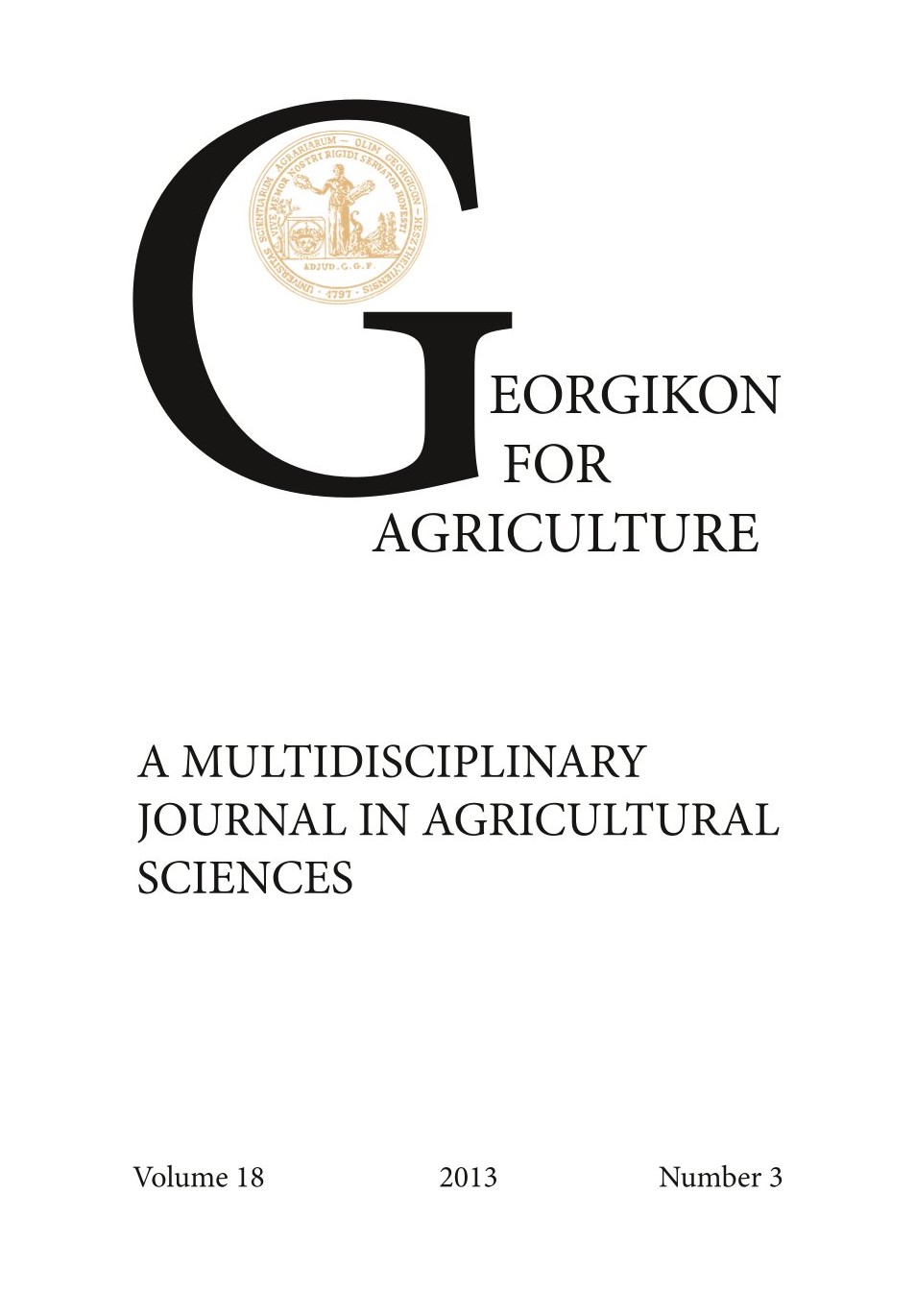Assessing oil retention map with pedotransfer fuctions for a study area at Keszthely, Hungary
Kulcsszavak:
oil retention, pedotransfer functions, digital soil mapping methods, liquid limit according to AranyAbsztrakt
A talajok olajszennyezése a leggyakoribb talajszennyezések egyike. Bármely talaj, amelyet érint az emberi tevékenység és a robbanómotorok használata, ki van téve ennek a kockázatnak valamilyen mértékben, ezért fontos, hogy a talajok érzékenységét térképszerűen becsülni tudjuk. Célunk volt, hogy kifejlesszünk egy erre alkalmas becslési módszert. A talajok olajvisszatartó képességét egy korábbi kutatás során vizsgáltuk különböző nyomásokon, és megállapítottuk, hogy egy bár nyomáson a szerves anyag tartalom és a homoktartalom a legfontosabb befolyásoló tényezők. Azonban a szokásos talajvizsgálatok során Magyarországon nem határozzák meg a talajok szemcseméret összetételét, így homoktartalmát sem, csak az Arany-féle kötöttségi számot mérik. Továbbá a jelenlegi talajvizsgálatok térbeli sűrűsége sem elég nagy ahhoz, hogy azokból térbeli becslést lehessen végezni. Kifejlesztettünk egy módszert, amellyel a szokásos talajvizsgálati adatokból meghatározhatók a legvalószínűbb szemcseméret eloszlás arányok, és a múltbéli összes elérhető talajvizsgálati adatot felhasználva becslést készítettünk egy Keszthely melletti mintaterületre a talaj szerves anyag és homoktartalmára vonatkozóan. Ezekből az alaptérképekből kiindulva becsültük a talaj felső rétegének olajvisszatartó képességét egy bár nyomáson. Az alkalmazott módszerek átlagoló tulajdonság amiatt (regresszió analízis, kriging) az átlag körüli értékek (19.1 térfogat %) gyakoriak voltak a becsült térképen, de hiányoztak a szélsőségesen nagy és kis értékek, amelyek pedig a becslőegyenlet kifejlesztéséhez használt adatbázisban szerepeltek.
Hivatkozások
Arany, S. 1943. A talajok rögszerkezete. Mezőgazd. Kut. 16. 220–249.
Chiu, C. F., Yan, W. M., Yuen, K. V. 2012. Estimation of water retention curve of granular soils from particle-size distribution - a Bayesian probabilistic approach. Canadian Geotechnical Journal. 49. 1024–1035. https://doi.org/10.1139/t2012-062
Dobos, E., Bialkó, T., Michéli, E., Kobza, J. 2010. Legacy soil data harmonization and database development. p. 309–323. In J. L. Boettinger, D. W. Howell, A. C. Moore, A. E. Hartemink, S. Kienast-Brown (eds.) Digital Soil Mapping. Progress in Soil Science 2, Springer Science+Business Media B. V., Berlin, Heidelberg. https://doi.org/10.1007/978-90-481-8863-5_25
Ébényi, Gy. 1942. Magyarázatok Magyarország geológiai és talajismereti térképéhez. Keszthely. No. 5258/4. M. Kir. Földtani Int., Budapest.
EC 2007. Directive 2007/2/EC of the European Parliament and of the Council of 14 March 2007 establishing an Infrastructure for Spatial Information in the European Community (INSPIRE).
Fingas, M. 2013. The basics of oil cleanup. CRC Press Taylor and Francis. Boca Raton, 11–20. https://doi.org/10.1201/b13686
Géczy, G. 1960. Újabb mezőgazdasági talajhasznosítási osztályozási rendszer. Agrokémia és Talajtan. 9. 405–418.
Hernádi, H. 2012. A talaj olajvisszatartó képességének becslési lehetőségei. Agrokémia és Talajtan. 61. 399–416. https://doi.org/10.1556/agrokem.60.2012.2.12
Kreybig, L. 1937. A M. Kir. Földtani Intézet talajfelvételi vizsgálati és térképezési módszere. M. Kir. Földtani Int., Budapest.
Makó, A. 2002. Measuring and estimating the pressure-saturation curves on undisturbed soil samples using water and NAPL. Agrokémia és Talajtan. 51. 27–36. https://doi.org/10.1556/agrokem.51.2002.1-2.4
Makó, A. 2005. Measuring the two-phase capillary pressure-saturation curves of soil samples saturated with nonpolar liquids. Communications in Soil Sciences and Plant Analysis. 36. 439–453. https://doi.org/10.1081/CSS-200043170
Makó, A., Hernádi, H. 2012. Kőolajszármazékok viselkedése a talajban. p: 13-77. In Makó A., Hernádi H. (szerk.) Kőolajszármazékok a talajban: talajfizikai kutatások. Pannon Egyetem Georgikon Kar, Keszthely.
Makó, A., Tóth, B., Hernádi, H., Farkas, Cs., Marth, P. 2010. Introduction of the Hungarian Detailed Soil Hydrophysical Database (MARTHA) and its use to test external pedotransfer functions. Agrokémia és Talajtan. 59. 29–39. https://doi.org/10.1556/agrokem.59.2010.1.4
McBratney, A., Mendonca-Santos, M. L., Minasny, B. 2003. On digital soil mapping. Geoderma. 117. 3–52. https://doi.org/10.1016/S0016-7061(03)00223-4
Németh, T., Stefanovits, P., Várallyay, Gy. 2005. Talajvédelem. Országos Talajvédelmi Stratégia tudományos háttere. Kármentesítési tájékoztató. Környezetvédelmi és Vízügyi Minisztérium. Budapest.
Pásztor, L., Szabó, J., Bakacsi, Zs. 2010. Application of the Digital Kreybig Soil Information System for the delineation of naturally handicapped areas in Hungary. Agrokémia és Talajtan. 59. 47–56. https://doi.org/10.1556/agrokem.59.2010.1.6
Sisák, I., Bámer, B. 2007. A teljes termőterületet magába foglaló nagyléptékű talajtérkép létrehozásának szükségessége és lehetősége. p. 182–192. In T. Tóth, G. Tóth, T. Németh and Z. Gaál (eds.) Földminősítés és földhasználati információ. MTA-TAKI, Budapest.
Letöltések
Megjelent
Folyóirat szám
Rovat
License
Copyright (c) 2013 Sisák István, Makó András, Pőcze Tamás

This work is licensed under a Creative Commons Attribution-NonCommercial-NoDerivatives 4.0 International License.
The articel is under the Creative Commons 4.0 standard licenc: CC-BY-NC-ND-4.0. Under the following terms: You must give appropriate credit, provide a link to the license, and indicate if changes were made. You may do so in any reasonable manner, but not in any way that suggests the licensor endorses you or your use. You may not use the material for commercial purposes. If you remix, transform, or build upon the material, you may not distribute the modified material. You may not apply legal terms or technological measures that legally restrict others from doing anything the license permits.




 Georgikon for Agriculture
Georgikon for Agriculture